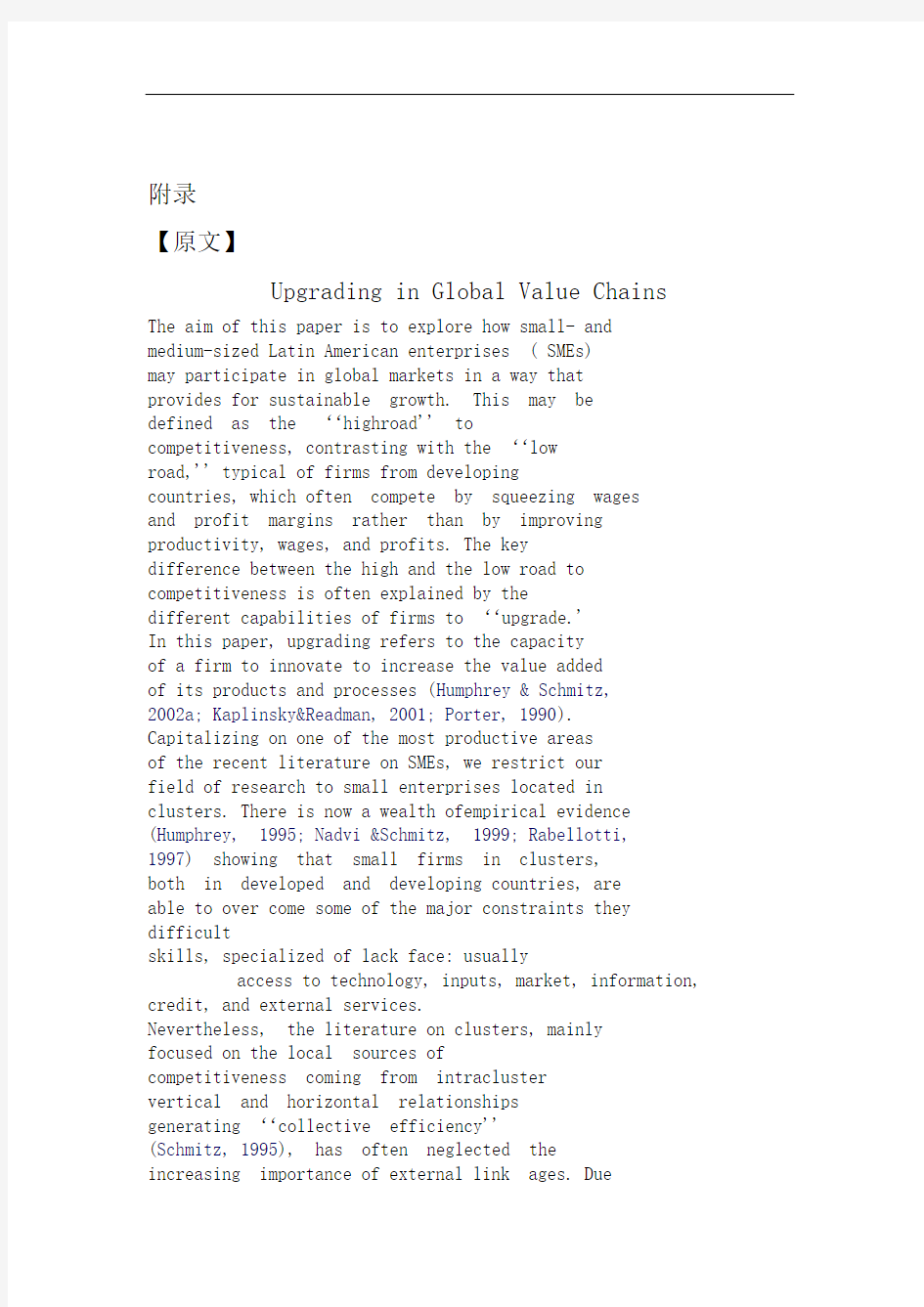经济金融企业管理外文翻译外文文献英文文献

- 1、下载文档前请自行甄别文档内容的完整性,平台不提供额外的编辑、内容补充、找答案等附加服务。
- 2、"仅部分预览"的文档,不可在线预览部分如存在完整性等问题,可反馈申请退款(可完整预览的文档不适用该条件!)。
- 3、如文档侵犯您的权益,请联系客服反馈,我们会尽快为您处理(人工客服工作时间:9:00-18:30)。
附录
【原文】
Upgrading in Global Value Chains
The aim of this paper is to explore how small- and
medium-sized Latin American enterprises ( SMEs)
may participate in global markets in a way that
provides for sustainable growth. This may be
defined as the ‘‘highroad'' to
competitiveness, contrasting with the ‘‘low
road,'' typical of firms from developing
countries, which often compete by squeezing wages
and profit margins rather than by improving productivity, wages, and profits. The key
difference between the high and the low road to competitiveness is often explained by the
different capabilities of firms to ‘‘upgrade.'
In this paper, upgrading refers to the capacity
of a firm to innovate to increase the value added
of its products and processes (Humphrey & Schmitz,
2002a; Kaplinsky&Readman, 2001; Porter, 1990).
Capitalizing on one of the most productive areas
of the recent literature on SMEs, we restrict our
field of research to small enterprises located in
clusters. There is now a wealth ofempirical evidence (Humphrey, 1995; Nadvi &Schmitz, 1999; Rabellotti,
1997) showing that small firms in clusters,
both in developed and developing countries, are
able to over come some of the major constraints they
difficult
skills, specialized of lack face: usually
access to technology, inputs, market, information, credit, and external services.
Nevertheless, the literature on clusters, mainly
focused on the local sources of
competitiveness coming from intracluster
vertical and horizontal relationships
generating ‘‘collective efficiency''
(Schmitz, 1995), has often neglected the
increasing importance of external link ages. Due
to recent changes in production
systems, distribution channels, and financial
markets, and to the spread of information
technologies, enterprises and clusters are
increasingly integrated in value chains that
often operate across many different countries. The
literature on global value chains
(GVCs) (Gereffi, 1999; Gereffi& Kaplinsky, 2001)
calls attention to the opportunities
for local producers to learn from the global leaders
of the chains that may be buyers or
1
producers. The internal governance of the value chain has an important effect on the scope of local firms' upgrading (Humphrey& Schmitz, 2000). Indeed, extensive evidence on Latin America reveals that both the local and the global dimensions matter, and firms often participate in clusters as well as in value chains (Pietrobelli& Rabellotti, 2004). Both forms of
organization offer opportunities to foster competitiveness via learning
and upgrading. However, they also have remarkable drawbacks, as, for
instance, upgrading may be limited in some forms of value chains, and clusters with little developed external economies and joint actions may have
no influence on competitiveness.
Moreover, both strands of literature were conceived and developed to overcome the sectoral dimension in the analysis of industrial organization
and dynamism. On the one hand, studies on clusters, focusing on agglomerations of firms specializing in different stages of the filie′re,
moved beyond the traditional units of analysis of industrial economics:
the firm and the sector. On the other hand, according to the value chain literature, firms from different sectors may all participate in the same value chain (Gereffi, 1994). Nevertheless, SMEs located in clusters and involved in value chains, may undertake a process of upgrading in order to
increase and improve their participation in the global economy, especially
as the industrial sector plays a role and affects the upgrading prospects of SMEs.
The contribution this paper makes is by taking into account
